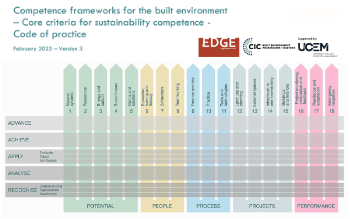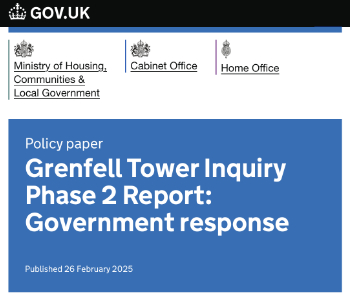UK construction industry
Contents |
[edit] Introduction
Construction is a very diverse industry that includes activities ranging from mining, quarrying and forestry to the construction of infrastructure and buildings, the manufacture and supply of products, as well as maintenance, operation and disposal.
Construction output in the UK is more than £110 billion per annum and contributes 7% of GDP (ref. Government Construction Strategy). Approximately a quarter of construction output is public sector and three-quarters is private sector.
There are three main sectors (ref. Government Construction Strategy):
- Commercial and social (approximately 45%).
- Residential (approximately 40%).
- Infrastructure (approximately 15%).
Approximately 60% of construction output is new build, whilst 40% is refurbishment and maintenance.
The industry accounts for approximately 3 million jobs, 10% of total UK employment (ref Construction 2025) and includes both manufacturing and services. According to the Department for Business Innovation and Skills, the industry is made up as follows:
- Contracting, 2,030,000 jobs, 234,000 businesses.
- Services, 580,000 jobs, 30,000 businesses.
- Products, 310,000 jobs, 18,000 businesses.
(Ref. BIS, UK Construction, An economic analysis of the sector, July 2013.)
Construction is a high-cost, high-risk, long-term activity, and so its performance is a good indicator of the heath of the wider economy. When the economy falters, construction investment grinds to a halt, but when the economy begins to recover, the construction industry can quickly overheat.
[edit] Leadership and governance
Construction comes within the remit of the Department of Business, Innovation and Skills. However, planning and building regulations fall under the Department for Communities and Local Government. To further confuse matters, the Government Construction Board reports to the Minister for the Cabinet Office and the Cabinet Office is also the home of the Efficiency and Reform Group which includes the Major Projects Authority.
The abolition of the role of Chief Construction Adviser in November 2015, and the taking over of responsibility for the Government Construction Strategy by the Cabinet office minister has made the position even more confused.
In addition, a Construction Leadership Council (CLC) was established in 2013 to oversee implementation of Construction 2025: industrial strategy for construction. This is an industry/government council jointly chaired by the Secretary of State for Business, Innovation and Skills and an industry representative.
Other organisations also have involvement in the governance of construction:
- British Waterways Board.
- Civil Aviation Authority.
- Design Council CABE.
- English Nature.
- Environment Agency.
- Health and Safety Executive.
- Historic England.
- Highways England.
- Local authorities.
- Port of London Authority.
See Statutory consultees and Non-statutory consultees for more information.
In addition, the industry has established numerous boards, councils, institutes and associations to lobby, develop, promote and regulate construction activities:
- Actuate UK
- Building Services Research and Information Association (BSRIA)
- Chartered Institute of Building (CIOB)
- Chartered Institution of Building Services Engineers (CIBSE)
- Constructing Excellence (CE)
- Construction Industry Research and Information Association (CIRIA)
- Construction Industry Training Board (CITB)
- Construction Products Association (CPA)
- Construction Project Information Committee (Cpic)
- Institution of Civil Engineers (ICE)
- Institution of Structural Engineers (Istructe)
- National Building Specification (nbs)
- Royal Institute of British Architects (RIBA)
- Royal Institution of Chartered Surveyors (RICS)
- Royal Town Planning Institute (RTPI)
- UK Contractors Group (UKCG)
For more information, see Construction industry institutes and associations and Construction industry organisation.
A number of these institutes and associations are members of the Construction Industry Council (CIC) which describes its mission as providing, ‘…a single voice for professionals in all sectors of the built environment’
[edit] Criticism
The UK construction industry is regularly criticised for being wasteful, adversarial, fragmented, dominated by single disciplines, reluctant to innovate and poor at disseminating knowledge (see Construction industry reports for more information).
However, given that despite a great number of reports about the industry, and numerous attempts to improve efficiency, the perception or poor performance persists, it might be inferred either that; under the circumstances the industry operates more effectively than it appears from the outside; expectations are unrealistic; or recommendations have been consistently poorly implemented.
[edit] Challenges
The UK construction industry faces a number of very serious challenges:
[edit] Urbanisation
In 1900 only 16% of the population lived in urban areas. Over half of the planet's population now lives in cities (ref https://ourworldindata.org/urbanization). These densely occupied areas should be more sustainable than more dispersed rural settlements, but in fact they account for more than 75% of the consumption of non-renewable resources, and create around three quarters of global pollution.
By the second half of the century, more than 70% will live in cities, and at the same time global population will increase from 7 billion to around 9.5 billion. If we are to accommodate this growth whilst at the same time reducing overall consumption, our design and construction needs to become much smarter.
See Smart Cities for more information.
[edit] Climate change and sustainability
The UK government has committed to cut green house gas emissions by 80% by 2050 compared to 1990 levels, and to halve them by 2025. In 2009 buildings accounted for about 43% of all the UK’s carbon emissions (ref. DCLG). If the government commitment is to be met, buildings must become considerably more efficient. This is made more complicated by the fact that around 80% of the UK building stock that will exist in 2025 has already been built, along with two thirds of the housing that will be occupied in 2050.
Not only does our building stock need to become more efficient, if the climate changes as projected, it will also need to become more resilient.
However, government policy, such as scrapping the Green Deal, dropping plans for zero-carbon homes, and reducing subsidies for renewables would seem to be contrary to these goals.
[edit] Government construction strategy
The Government Construction Strategy has set in motion two major initiatives:
- An intention to achieve savings of 15 - 20% by the end of the parliament.
- A requirement for fully-collaborative 3D BIM on all centrally-procured construction contracts by 2016.
See Government Construction Strategy for more information.
Some of these targets have been developed and extended by Construction 2025.
[edit] Performance gap
There is significant evidence to suggest that buildings do not perform as well in practice as was anticipated at the design stage. The difference between anticipated and actual performance is known as the performance gap.
Findings from the PROBE studies (Post Occupancy Review of Buildings and their Engineering) demonstrated that actual energy consumption in buildings will usually be twice as much as predicted. More recent findings from the Carbon Trust‘s Low Carbon Buildings Accelerator and the Low Carbon Buildings Programme have demonstrated that in-use energy consumption can be 5 times higher than compliance calculations.
See Performance gap for more information.
[edit] Procurement
Typically, a construction project will involve a funder, client, consultants, contractor, sub-contractors and suppliers. They will generally be procured following one of the five main procurement routes:
- Traditional contract.
- Design and build.
- Construction management.
- Management contract.
- Public procurement.
For more possibilities, see Procurement routes.
A typical traditional contract will include the following stages:
- Stage 1: Business justification.
- Stage 2: Feasibility studies.
- Stage 3: Project brief.
- Stage 4: Concept design.
- Stage 5: Detailed design.
- Stage 6: Production information.
- Stage 7: Tender.
- Stage 8: Mobilisation.
- Stage 9: Construction.
- Stage 10: Occupation and defects liability period.
- Stage 11: Post occupancy evaluation.
Other stage definitions can be seen in comparison of work stages.
See also: Construction industry organisation
[edit] Related articles on Designing Buildings Wiki
- Acronyms.
- BBA becomes an Approved Body for UKCA Marking.
- Brexit standards, products and regulatory updates.
- Building regulations.
- Chartered builders and chartered construction managers receive official recognition in Northern Ireland public procurement.
- CLC publishes Conformity Marking of Construction Guide.
- Comparison of work stages.
- Composition of UK construction industry 2013.
- Construction 2025.
- Construction industry institutes and associations.
- Construction industry organisation.
- Construction industry outlook on the upswing.
- Construction industry reports.
- Construction Leadership Council.
- Construction market forecast 2015 to 2024.
- Construction minister.
- Construction output and GDP for quarter 4 2019.
- Construction sector deal.
- Copronet digital hub is designed to improve the construction industry.
- Devolution.
- Global construction market projections from 2020 to 2030.
- Government construction strategy.
- Housing minister.
- Irish construction may struggle to meet demands.
- Non-statutory consultees.
- Other construction industry organisations.
- Performance gap.
- Perkins review of engineering skills.
- Planning permission.
- Procurement route.
- Skills to build.
- Smart cities.
- Statutory consultees.
- Sustainability.
- The CIOB welcomes assurance of Exchequer-funded capital projects in Ireland.
- The state of UK construction August 2012.
- Top seven trends that will dominate the future of the construction industry
- UK.
- UK Construction industry occupations by percent.
[edit] External references
- BIS, UK Construction, An economic analysis of the sector, July 2013.
- The Carbon Trust, Building a lower carbon construction industry
Featured articles and news
Microcosm of biodiversity in balconies and containers
How minor design adaptations for considerable biodiversity benefit.
CIOB student competitive construction challenge Ireland
Inspiring a new wave of Irish construction professionals.
Challenges of the net zero transition in Scotland
Skills shortage and ageing workforce hampering Scottish transition to net zero.
Private rental sector, living standards and fuel poverty
Report from the NRH in partnership with Impact on Urban Health.
.Cold chain condensing units market update
Tracking the evolution of commercial refrigeration unit markets.
Attending a conservation training course, personal account
The benefits of further learning for professsionals.
Restoring Alexander Pope's grotto
The only surviving part of his villa in Twickenham.
International Women's Day 8 March, 2025
Accelerating Action for For ALL Women and Girls: Rights. Equality. Empowerment.
Lack of construction careers advice threatens housing targets
CIOB warning on Government plans to accelerate housebuilding and development.
Shelter from the storm in Ukraine
Ukraine’s architects paving the path to recovery.
BSRIA market intelligence division key appointment
Lisa Wiltshire to lead rapidly growing Market Intelligence division.
A blueprint for construction’s sustainability efforts
Practical steps to achieve the United Nations Sustainable Development Goals.
Timber in Construction Roadmap
Ambitious plans from the Government to increase the use of timber in construction.
ECA digital series unveils road to net-zero.
Retrofit and Decarbonisation framework N9 launched
Aligned with LHCPG social value strategy and the Gold Standard.
Competence framework for sustainability
In the built environment launched by CIC and the Edge.
Institute of Roofing members welcomed into CIOB
IoR members transition to CIOB membership based on individual expertise and qualifications.
Join the Building Safety Linkedin group to stay up-to-date and join the debate.
Government responds to the final Grenfell Inquiry report
A with a brief summary with reactions to their response.


























Comments
Very interesting article about UK's construction industry. Have a look on the restrictions that construction companies in UK are facing: https://geniebelt.com/blog/uk-construction-restrictions